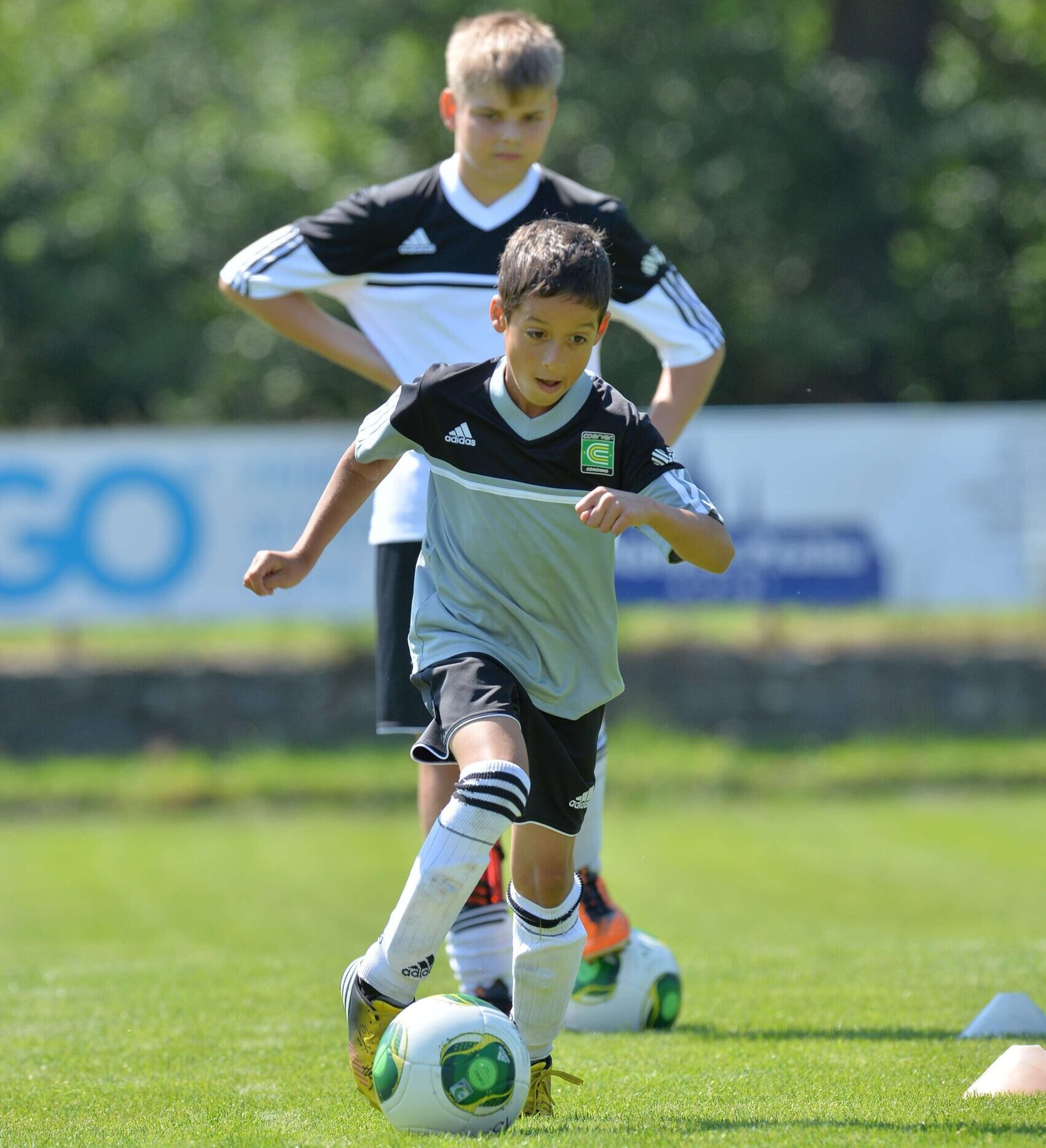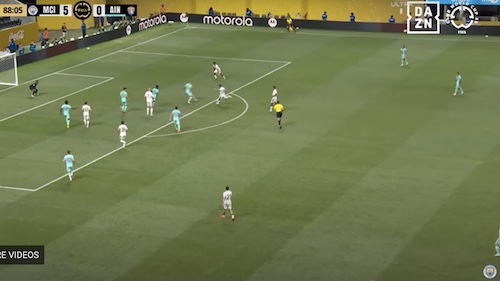by Pierre Barrieu
Head Fitness Coach for U.S. Men’s National Soccer Team
Warming up: justification and structure
By definition, the primary goal of any warm up is to raise the body core’s temperature and subsequently, the muscles temperature. This is made possible via an increase of blood flow; which itself is a direct consequence of increase of both heart and respiratory rates. The blood flow will deliver oxygen and nutrients to the active muscles.
This increase in temperature will considerably improve the elasticity of muscles, tendons, ligaments, and soft tissues in general in order to prepare the body for the physical activity to follow.
Common warm ups are usually divided in 2 to 3 distinctive sections, depending on various factors. We could name some such as time, weather or coach’s specificities but this is part of a much larger list.
During part 1, called the general warm up, the coach would basically put his players in motion, using any kind of physical activity in order to “break a sweat”
Part 2 generally consists in a static stretching segment. Stretching “Static” is a form of stretching performed according to the following procedure: the player slowly and cautiously positions his body so that it will increase the tension of the muscle, or group of muscles, to be stretched. When reaching that point, the position or posture is held in order to allow the muscles and tendons to lengthen. Static stretching is generally passive in a sense that agonist (muscle to be stretched) and antagonists muscles (muscles performing the opposite function, usually located behind or in front of the stretched muscle) are relaxed.
Unfortunately some warm ups end up here, without going any further in the sport specificity and the subsequent specific muscles involvement. There is nowadays a modern and more scientific conception of the adequate warm up; which would consist in one to two more additional segments.
This final section, usually called specific warm up, can either combine sport specific movements with dynamic stretching movements; or reserve two separate segments for each one.
In this case, there would be a distinct sport specific movements segment, followed by the final segment where ballistic stretching movements will be performed. (REF)
The following article focuses on the sport specific part of the warm up. It aims at justifying the use of ballistic stretching during sport in general, and soccer in particular, warm ups.
We will first establish a review of where the research stands on the topic to these days then we will try to submit a simple, easy to set up, protocol for soccer specific warm up.
The goals of stretching:
When it comes to soccer, improving flexibility will help prevent injuries and improve speed. When practice volume pick ups it will also help prevent and get rid of soreness.
Numerous researches have demonstrated the effects of stretching on achieving the goals above cited.
Preventing injuries:
A structured stretching routine will consistently increase Range Of Motion (ROM) (6,7,13,14); which itself has been proven to ultimately help preventing injuries (14,15). Stretching combine both of these virtues because similar muscle contraction mode (eccentric/concentric/isometric) or speed of contraction as in the targeted sport, can be used. This is where dynamic stretching takes his entire dimension. Moller, Oberg and Gillquist (6) found that between soccer training only / soccer training using a contract relax stretch at warm up and static stretching following a soccer training. Only static stretching following soccer training would best increase hip extension, hip flexion and knee flexion
Speed development:
Good muscles flexibility is the condition sine qua non for the “limbs to travel through a range of motion without impediment to make the running movement fluid and efficient. To develop speed, a runner should emphasize flexibility at the hip, thigh and lower leg. It is interesting that Cissik (2), points out that combining static stretching with dynamic stretching (the equivalent of our ballistic stretching), “will allow a runner to increase movement and speed development and increase stride length and stride frequency”. 3) As we all know, a lot of coaches have been using static stretching for years, in order to prevent or get rid or soreness. Interestingly, many researches have been recently studying the impact that static stretching can have. The unanimous conclusion was that static stretching makes no impact on DOMS (Delayed Onset of Muscle Soreness). But some others seem to make one.
For Cheung, Hume and Maxwell: “Cryotherapy, stretching, homeopathy, ultrasound and electrical current modalities have demonstrated no effect on the alleviation of muscle soreness or other DOMS symptoms. Similarly, massage has shown varying results that may be attributed to the time of massage application and the type of massage technique used.” (10) 2003.
According to Herbert and Gabriel, “Stretching before or after exercising does not confer protection from muscle soreness” (11) 2003
Also for Connolly, Sayers and McHugh: “Selected treatments such as anti-inflammatory drugs and antioxidants appear to have a potential in the treatment of DOMS. Other conventional approaches, such as massage, ultrasound, and stretching appear less promising. (9)
Finally, static stretching has even been found to induce significantly more DOMS than ballistic stretching by Smith, Brunetz, Chenier, McCammon, Houmard, Franklin and Israel (1)
Between numerous studies, which have been trying to determine ideal static stretching duration, we tried to narrow it down to some specific soccer or soccer muscles studies, more particularly on the adductors muscles.
So now, when do your players better hold the stretch or stretch with speed ? Static vs. ballistic?
We have already discussed static stretching but what is ballistic stretching?
Looking at definitions:
Ballistic: adjective, of or related to a body in motion according to the laws of ballistics.
Ballistics: name. The science of the motion of projectiles in flight.
Applied to stretching for sport, ballistic stretching can be defined as stretching with motion, speed. Therefore, the position will be obtained after an active motion of the limb or joint, and held for a short amount of time.
Great confusion has been created over the years by a wrong perception and understanding of what ballistic stretches are… and also by the fear a novelty demonstrated by some “old school” coaches.
This confusion has also been fueled by a semantic misconception. Therefore we need to clarify a little more what we call dynamic stretching, a generic name for 2 distinct stretching methods.
Ballistic stretching (Also called bouncing stretching) is not the same as dynamic stretching… even if both are ballistic by nature.
The dynamic stretching I recommend does not hold the stretching position (reached after an active motion) more than 2s. Therefore it cannot be considered as bouncing stretching, where a certain amount of active stretching movement repetitions are performed once the static stretching position is reached, in the range itself.
Dynamic stretching is a form of ballistic stretching but made of particular movements and sequences and also following a different physiological and anatomical justification.
A definition by Kurz (3) sums it up: according to him, dynamic stretching “involves moving parts of your body and gradually increasing reach, speed of movement, or both. He also warns:” Do not confuse dynamic stretching with ballistic stretching! Dynamic stretching consists of controlled leg and arm swings that take you (gently!) to the limits of your range of motion. Ballistic stretches involve trying to force a part of the body beyond its range of motion.
Let’s take the example of a standing straight legs Hamstring stretch.
Dynamic version: From the standing position, reach for your toes, keeping both knees locked and leg straight / reach the stretch position / extend the trunk back to return to starting (standing) position.
“Bouncing” or “ballistic” version: From the standing position, reach for your toes, keeping both knees locked and leg straight, once you have reached the stretch position, try to reach deeper, by executing repetitive bouncing movements (up to 10) before finally extending back to the starting (standing) position.
We can easily identify the difference between these two types of stretching, both ballistic by definition, but totally different from a physiological standpoint.
According to some studies, bouncing stretching has been shown to cause muscle soreness probably the result of micro-trauma within the muscle fibers, and is therefore not advisable for most activities. It’s also been suggested that bouncing stretching does not even lengthen the muscle fibers, but more the tendons and fascia connected to and surrounding those muscles.
Note that both of these stretching methods are based on the neurophysiological phenomenon involving the stretch reflex. The stretch reflex is a mechanism, which starts with a signal, sent by the brain, to the muscles sensor as the muscle stretches, or after two seconds in a stretched position. It then causes the muscle to begin a slow and contrary contraction. The stretch reflex is basically the body safety device against overstretching and subsequent muscle fiber tears.
Continuing to stretch, or forcing during the stretch reflex phase, is equivalent to stretching when the muscle tries to contract in the opposite direction. This is when it can become source of problem and this is where static stretching reaches his limitations. Even if his goal is to inhibit the stretch reflex, stretching should never be held beyond light irritation. Therefore, the improvement in range of motion appears limited, after a few seconds.
So, how long should I hold it for ?
In a research case by Stanford University School of Medicine (4), 72 men were randomly divided into four groups: Members of one group statically stretched their hip adductors for 15 seconds at a time, individuals in a second group stretched for 45 seconds, and men in a third group attempted to loosen their adductors for two minutes at a time (a fourth, non-stretching group served as a control). Their conclusion was that there is no difference in hip-adductor flexibility between the groups: 15 seconds of stretching was just as effective as two minutes, in terms of un-tightening the adductor muscles.
Stretching for Soccer:
As we have (unfortunately) seen, static stretching remains the most widely used form of stretching during soccer warm ups. It always strikes me when I observe players performing a very basic standing split adductors (groin) stretch… minutes away from kick off.
Injury to the hip adductors most commonly occurs following forced push-off (side-to-side motion, in our case a cutting motion); where an extreme amount of stress is placed on the adductor tendons when, because of the athlete’s momentum, a large amount of force is applied to one side in the sagittal plane and the adductor muscles must contract rapidly to shift the force to the opposite direction. Despite of that, most the coaches, or players themselves, impose an isometric (static) stretch to the adductors, when these muscles are soon going to be stressed completely differently, as soon as the game as started.
Indeed, during the first cutting motions of the game, and the many other ones to follow, an eccentric stretching action (Muscle fibers going away from each other), aggravated by the angular velocity (speed of stretching), combined with the biomechanics of the motion described above will put the muscle in a dramatically more stressful situation than a simple static stretch. Therefore, limiting the pre game routine only to static stretching appears to the soccer player’s muscle integrity at risk.
The way to ultimately better prepare a muscle for soccer specific exists. Using ballistic stretching in the final part of your warm up goes back to the notion of sport specificity…by simply reproducing some sport specific motions and, though to lesser extent, mimic mechanism of injuries in order to accustom the muscles; ballistic stretching movements appear to be a great complement to any pre game routine or warm ups. Looking at Tables 1 and 2 and 3, we can see that muscle, and hamstrings strains in particular, still represents half of the soccer injuries (12). Ballistic stretching will ultimately help preparing the targeted muscles.
Table 1 Location of injuries sustained during pre and in season periods.
Looking closely at Hamstring injury. How can dynamic stretching help preventing it?
The mechanism of injury for an hamstring strain is the following: eccentric load due to deceleration of the limb (extended knee) during the late swing phase of the gait cycle, or during take off sudden change of muscles function, from stabilizing the knee in flexion to assisting in paradoxical active extension of the knee.
On a stretching standpoint, reproducing the eccentric contraction, in order to accustom and strengthen the muscle, will help. The same applies to the weightlifting where the focus should be on exercises, which strengthen the hamstrings eccentrically.
Practical examples of ballistic stretches:
Here are some soccer specific ballistic stretches to incorporate in a warm up routine:
Example:
Hamstrings: HF split, B skips. leg swings
Hamstrings and back
Groin and Hamstrings: lateral leg swings, rubber bands
Conclusion:
Static stretching helps increasing range of motion but, although used for years in soccer warm-up, does not prepare adequately for a soccer game. The best duration for static stretching appears to be anywhere around 15 seconds.
Incorporating Dynamic Stretching as part of your warm up is one way to help achieving soccer specific flexibility, in order to prevent muscles injuries.
However, it cannot totally eliminate the risk of soft tissues injuries. In the case of hamstrings injuries for example, aside from lack of flexibility or lack of adequate warm up, they still remain primarily caused by strength imbalance, strength imbalance of 10% or more between the right and left thighs, flexor-extensor ratio of less than 0.6, pre existing conditions such as old scars, genetics (nature of biceps femoris) and muscle fatigue.
It should be known that the dynamic form of stretching carries with it a risk of injury if used incorrectly; therefore it should only be used under the supervision of a strength and conditioning coach and/or trainer and/or certified coach. Proper stretching technique should always be used to insure effectiveness, specially when it comes to more complex movements, like the ones dynamic warm up is made of. Studies have found that holding the anterior pelvic tilt position was more important than stretching method for increasing hamstring muscle flexibility. (8)
Others stretching methods exist, aside from ballistic stretching, dynamic and static stretching already reviewed in the article. Passive (or relaxed) stretching, isometric stretching and proprioneuromuscular facilitation (or “PNF”) are also commonly employed in the sports domain. Some recent findings indicate great virtues to PNF, when used appropriately (6,7).
However, PNF stretching remains a little more complicated for a coach to set up because it always requires a partner and a proven familiarity and knowledge of these particular stretching movements.
Although not exposed in this article, I have found that between all the types of PNF (CITER TYPES), a Hold relax PNF stretching using a “Hold 6 to 10 sec. (To activate the Golgi receptors) / Relax for 10 to 15 sec” protocol, can significantly increase muscles and joints flexibility (5).
Soccer coaches should be able to design a well-targeted warm up, covering specific muscles with appropriated modes of contraction. Therefore ballistic stretching should take place in every soccer warm up.














